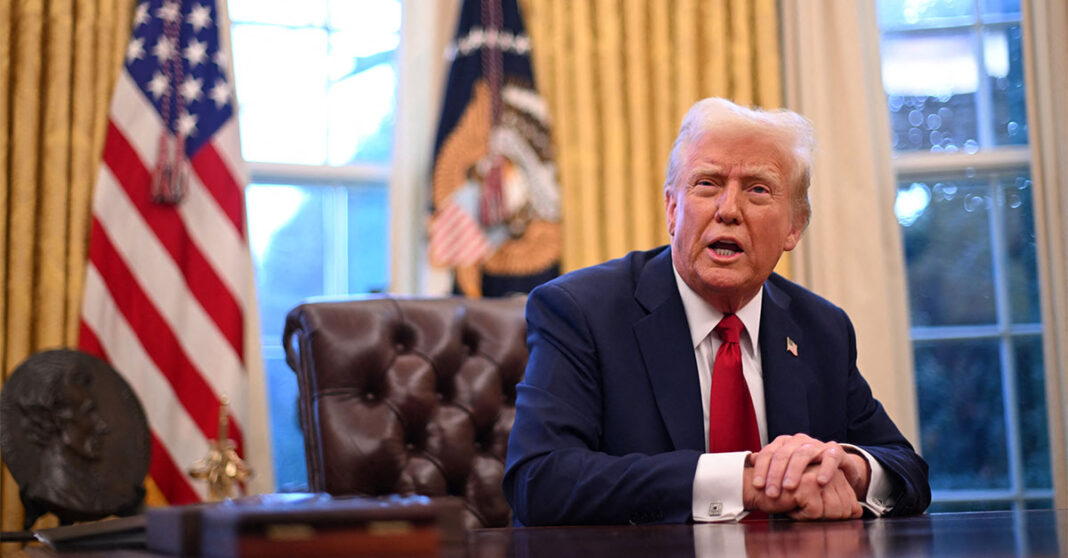Laos is among the countries most affected by the United States’ recent announcement of new reciprocal tariffs, which President Donald Trump unveiled on 2 April. This decision could have a severe impact on Laos’ economy and threaten its growing trade relationship with the U.S, according to economic experts.
Under President Trump’s “Liberation Day” tariff policy, imports from Laos will face both a universal tariff and an additional reciprocal tariff.
Starting 5 April, a 10 percent universal tariff will be applied to all imports into the United States.
Additionally, a 48 percent reciprocal tariff will take effect on 9 April, specifically targeting imports from Laos. This combined approach will result in a total tariff of 58 percent on Lao imports, comprising the 10 percent universal tariff and the 48 percent reciprocal tariff. However, the White House calculates 95 percent as the total barrier to trade.
President Trump determined the 95 percent tariff rate by calculating each country’s trade deficit with the U.S. as a percentage of total U.S. imports from that country, incorporating both monetary tariffs and non-monetary trade barriers. He then imposed reciprocal tariffs at half these calculated rates, positioning them as a “kind” response to trade disparities.
This marks a shift that could spell new challenges for Laos’s agricultural, textile, and light manufacturing sectors, which have relied on the U.S. as a growing export market.
For years, Laos has worked to expand its export base, with the U.S. emerging as a key trading partner. The country’s main exports to the U.S. include footwear, wood furniture, textiles, and electronics components. However, with the newly imposed tariff rates, Lao businesses might face a significant drop in orders from American buyers.
Lao coffee, one of the country’s signature exports, could also take a significant hit. The United States has been a growing consumer of high-quality Lao coffee, but the added cost from tariffs could push buyers toward alternative suppliers such as Colombia.
Wider ASEAN Impact: Cambodia, Vietnam, and Thailand Also Hit
Laos is not alone in facing severe economic consequences from Trump’s new tariffs. Other ASEAN nations have also been hit hard, with Cambodia facing a 49 percent tariff, Vietnam 46 percent, and Thailand 36 percent.
Cambodia, which heavily relies on textile and footwear exports to the U.S., now faces the highest tariff in ASEAN. Analysts predict job losses in the garment sector and potential factory closures.
Vietnam, with a 46 percent tariff, may see declining demand for its key exports like electronics, furniture, and garments. The country had been one of the biggest beneficiaries of past U.S.-China trade tensions, but this tariff now threatens its competitive edge.
Thailand, facing a 36 percent tariff, may see its auto parts, electronics, and seafood exports to the U.S. take a hit. Thai business leaders are calling for government intervention to negotiate better terms.
Experts warn that the collective impact of these tariffs on ASEAN economies could disrupt regional supply chains and slow down investment in manufacturing hubs that cater to U.S. markets.
Siwage Dharma Negara, a senior fellow at the ISEAS-Yusof Ishak Institute in Singapore, explained to The Guardian that recent tariffs imposed on Southeast Asian nations are primarily aimed at undermining China.
He noted that the administration likely believes these tariffs will impact Chinese investments in countries such as Cambodia, Laos, Myanmar, and Indonesia, which could in turn affect Chinese exports and the broader economy.
However, the consequences for these Southeast Asian countries could be severe, as Chinese investments in the region have been crucial in generating jobs and export revenue.
Laos may now be forced to look toward regional trade partners, particularly China, which has already been increasing its influence in Laos through major infrastructure projects, including the Laos-China Railway.
The tariff hike is part of Trump’s broader economic agenda, which aims to reduce the U.S. trade deficit and encourage domestic production. However, for smaller economies like Laos, the policy presents a major setback. Laos had hoped to leverage trade agreements and preferential tariffs to boost its economy, but these new policies threaten to unravel years of progress.
Lao Businesses, Government Comment
Small and medium-sized enterprises (SMEs), which make up the backbone of Laos’s economy, are particularly vulnerable. Many of these businesses have invested in expanding their operations to meet U.S. demand. Now, with higher tariffs reducing their competitiveness, they may face further challenges.
The Lao government has yet to issue an official response to Trump’s tariff policy, but trade officials have indicated they are closely monitoring the situation.
Meanwhile, ASEAN leaders are expected to hold emergency discussions on a collective response to the tariffs, as the region faces potential economic fallout. The tariffs are already causing ripples in Asian markets, with stock prices of export-reliant firms tumbling following Trump’s announcement.



